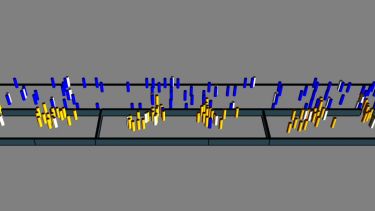RateSetter+ Passenger flow in stations during the COVID-19 pandemic
Research on pedestrian movement in stations has been adapted to improve planning for railway operation in periods of social distancing during the COVID-19 pandemic

Public transport is crucial to economic activity, functioning cities and access to work, but presents many pinch-points (doors, confined areas of queuing, ticket gates) where social distancing can significantly affect pedestrian flows, and in which social distancing is easily compromised. These points determine people flow rates, creating conflicting priorities in enabling functioning transport while maintaining social distancing safety.
Previously developed models for passenger movement in the boarding and alighting of trains were adapted to the pandemic situation. Social distancing was implemented in the models so that passengers would aim to maintain distance from one another, but not from surrounding doors/walls etc, i.e. a more sophisticated representation than just modelling very large people. Steering behaviours and the ability to judge when to board an already occupied train were implemented.
CCTV observation of real boarding and alighting behaviour was used to calibrate and validate the predictive models. These observations showed a tendency for people to compromise on distancing at the train door location, and this ‘real world’ behaviour was integrated into the modelling predictions.
The outcomes were integrated into a regional rail network model developed through Rail Safety and Standards Board to provide train operators and Network Rail with insight to how the network would behave in a range of possible scenarios as passengers returned to rail transport at the lifting of lockdown, enabling planning for different potential outcomes.
This work was supported by RSSB and the ESRC through grant number ES/W000601/1.
Staff
Professor David Fletcher Department of Mechanical Engineering
Professor Paul Richmond Department of Computer Science
John Charlton Department of Computer Science
Dr Sam Hayes Department of Mechanical Engineering
Twin Karmakharm Department of Computer Science
